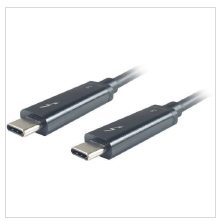
 Data Structure
Data Structure Networking
Networking RDBMS
RDBMS Operating System
Operating System Java
Java MS Excel
MS Excel iOS
iOS HTML
HTML CSS
CSS Android
Android Python
Python C Programming
C Programming C++
C++ C#
C# MongoDB
MongoDB MySQL
MySQL Javascript
Javascript PHP
PHP
- Selected Reading
- UPSC IAS Exams Notes
- Developer's Best Practices
- Questions and Answers
- Effective Resume Writing
- HR Interview Questions
- Computer Glossary
- Who is Who
What are the differences between Thunderbolt and USB-C?
Let us understand the concepts of Thunderbolt and USB-C before learning the differences between them.
USB-C
It is an industry-standard connector for transmitting the two information and force on a solitary link. It includes another, littler connector shape that is reversible so it's simpler to connect. USB-C links can convey essentially more force, so they can be utilized to charge bigger gadgets like PCs.
Most electronic gadgets, for example, PCs and other PC gear will incorporate at any rate one standard USB Type-A port, so any reasonable person would agree that USB connectors have been around for quite a while. Littler gadgets like cell phones, power banks, and outer hard drives will as a rule include either the little USB Type B connectors or miniaturized scale USB connectors to spare important space.
Out of nowhere, USB Type C connectors or USB-C as they're presently being called are being supported as a one-size-fits-all answer for charging and moving information between gadgets.
USB-C is the new rising standard for force and information, and will get omnipresent over most gadgets. It will likewise offer ascent to a scope of connectors for different kinds of connectors as gadgets become slimmer and progressively easier with regards to power and information ports.
Given below is the image of USB-C:

Thunderbolt
Thunderbolt interface is a specific type of hardware interface developed by intel in collaboration with Apple Inc. This interface is used for connecting hardware external peripherals and devices to a computer.
Advantages of thunderbolt
The advantages of thunderbolt are explained below −
Three-in-one technology
The primary advantage of Thunderbolt is that it acts as an interface and this combines PCI Express and DisplayPort into two serial data streams, in addition to DC connection for power.
While reducing cables and other interface ports, it expands the capability of a computer.
Graphic-based expansion capability
Thunderbolt is a low-latency and high-bandwidth interface which allows making a connection between a computer and an external graphics card unit or eGPU or eGFX. However, before connecting the integration of PCI Express into the serial data, the stream should be done.
If the Integration of PCI Express into the serial data stream not done then the graphic based expansion cannot done
Faster data transfer rates
Thunderbolt interface supports a data transfer rate of 10Gbps. The Thunderbolt 3 supports a transfer rate of up to 40Gbps. It allows the following −
Using thunderbolt streaming of HD and 4K UHD video to multiple monitors is made possible.
High-definition audio-video files are transferred very fast.
Fast charging of devices with 100W system charging and 15W to bus-powered devices is enabled.
Support for USB-C
It supports USB-C and other peripherals.
Given below is the image of thunderbolt:

Differences
The major differences between Thunderbolt and USB-C are as follows −
Thunderbolt technology which extends the capability of computers and its speed allows one to quickly access data when compared to USB.
Thunderbolt version 3 works at 40 Gbps whereas USB-C works at 10Gbps.
Thunderbolt allows a low latency and high bandwidth interface which allows connectivity between a computer and an external graphics card unit. That means thunderbolt has greater performance when it comes to Video display than USB.
Thunderbolt 3 can present video content on two 4K displays whereas USB-C can present only one 4K display.
Thunderbolt is more versatile than any other interface such as USB.
Thunderbolt is theoretically faster than USB and capable of hooking up more peripherals.
Expansion of Thunderbolt 3 is daisy-chained up to 6 Whereas the expansion of USB 3.0 can only connect one device.
External graphics of Thunderbolt 3 uses the PCI bus which enables the use of eGPU while external graphics of USB 3.0 cannot use eGPU.
Both are using legacy USB 3.x/2.x devices using an adapter with speed limited to device capabilities.

